I have been following Rich Brooks for a few years now and this is a fantastic article and helps drive part of your Social Commerce strategy
We and continuosly surprised at how few retail spaces take advantage of Twitter and Facebook (yes, there are exceptions). The costs are low, the risks are manageable and your customers are already using the platforms.
By engaging customers “where they live,” you can increase the foot traffic to your shop and grow your business.
Here are 5 steps to grow your retail business using Facebook and Twitter.
#1: Set Up Shop
“80 percent of success is just showing up.” – Woody Allen
This may sound obvious, but if you want to engage your customers and prospects on Twitter and Facebook, you have to be there.
On Twitter, this means creating an account for your business, but it also may mean creating an account for you or other people in your company. With few exceptions, people are more likely to follow a person rather than a business, and much more likely to engage with a person rather than a logo. By creating an account for both you and your business, you increase your chances for engaging your audience.

On Facebook, setting up shop means creating a business page and claiming your Facebook Place (more on that later). You should also have a Facebook profile for yourself that is linked to your page. Even if you’re a wallflower, this is good advice. Facebook provides more tools and functionality for pages that are linked to profiles.
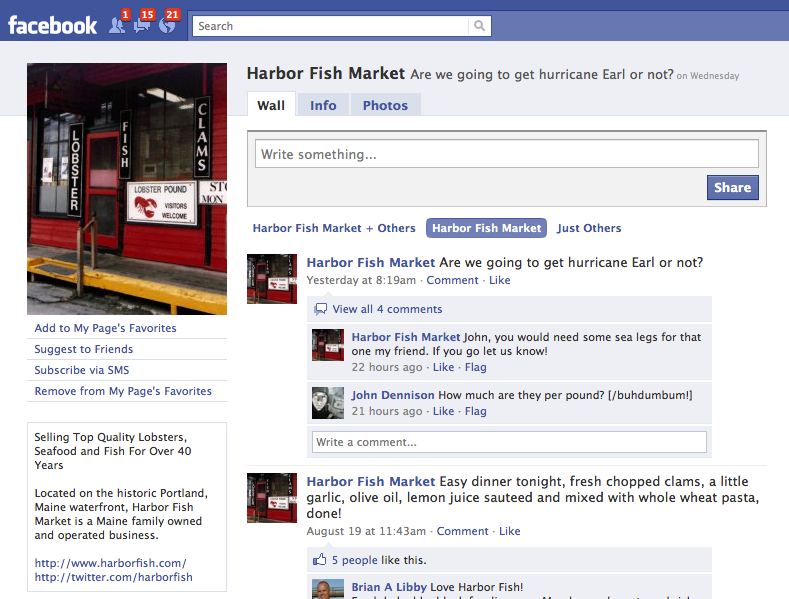
#2: Build Your Audience
The first step to getting someone to visit your brick-and-mortar store may be to get them to visit your Facebook page or follow you on Twitter.
Once you have your Twitter account and Facebook page set up, you should spend some time finding and building your audience on these platforms. Since many retail shops are “geographically challenged”—you can only do business with people within driving distance—finding local people is an essential first step.
For Twitter, I recommend visiting the advanced search. You can immediately limit your search to tweets within a geographic area, and refine it further by searching for specific terms. A chiropractor might search for “pain” within 15 miles of London, a florist might search for “anniversary” within 5 miles of Liverpool, and a restaurant might search for anyone within 10 miles of Brighton, as everyone I know needs to eat to survive.
An advanced search will bring up all the recent tweets that meet your criteria with the handle and avatar of the person who tweeted. From the results page you can follow these people or click on their profile for more information. Since following a person creates a knee-jerk reaction for them to follow you back, a certain percentage of these people will become your followers.
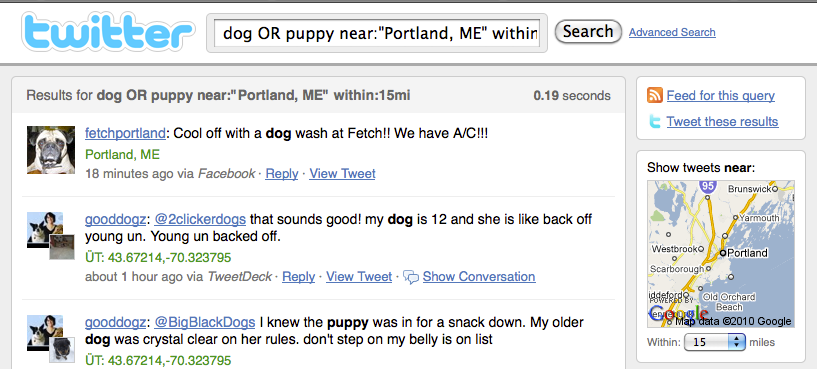
On Facebook, businesses don’t “fan” people, but you can still find your audience. Using targeted Facebook ads, leveraging your personal profile and creating a compelling landing page are all ways to build your fan base on Facebook. Mari Smith lists 21 Creative Ways to Increase Your Facebook Fanbase and Ching Ya lists more at 10 Ways to Grow Your Facebook Page Following.
#3: Create Content That Engages Your Audience
Just getting people to fan or follow you won’t bring them into your shop, however. You’ll need to create a steady stream of content to engage them. Whatever your business, you can create content that is compelling and relevant to your audience.
Own a restaurant? Post your lunch special to Facebook and Twitter, complete with a photo. As your fan base grows, you can ask them for suggestions on what they’d like to see as the daily special. Or run a contest on what to name your new sandwich where all the entries must be posted to your business page (which requires them to first fan your page).

Run an art supply store? Poll your audience on their favorite medium and why. Watercolors? Oil paint? Sculpture? (It’s amazing how much a simple question can energize a community.)
Are you the curator at the aquarium? Post a photo of a different fish every day with information about the fish and links back to your website where visitors can learn more and buy a day pass.
“Remember that a person’s name is to that person the sweetest and most important sound in any language.” – Dale Carnegie
You can take engagement to the next level by talking to or about a loyal customer.
On Twitter, it’s as simple as using their handle in a tweet. Maybe one of your most loyal customers participated in Tri for a Cure; if so, give her props. Or maybe you see that another customer is trying to sell his old truck on Twitter so you retweet his message. Little gestures go a long way.
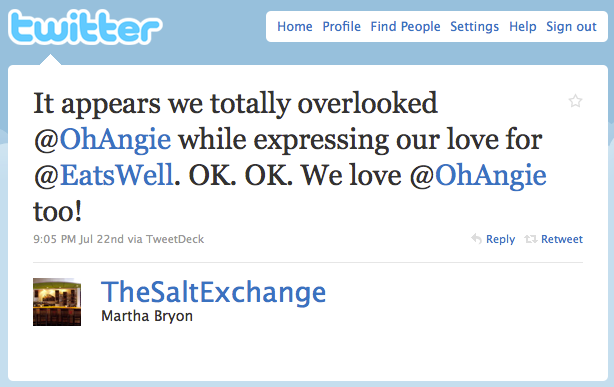
On Facebook, you can tag someone in an update. Since Facebook has a broader audience base, it’s probable that your update will be seen by more people (friends), especially if the person feels compelled to thank you in a comment to your initial post.
It should go without saying, but let me say it anyway: if the main purpose of you tagging everyone is to drive traffic to your page or account, it will show and it will backfire. As Dale Carnegie also said, “Give honest, sincere appreciation.”
#4: Leverage Location-Based Apps
This article isn’t a primer on FourSquare and Gowalla or how you can leverage these location-based apps. There are plenty of great resources out there for that, including How to Drive More Customers to Your Local Business with Social Geotagging and Why Foursquare Drives Business.
However, it’s important to realize that a lot of people are using location-based apps, and often linking them to their Twitter or Facebook accounts. In other words, when they check into a place they’re letting all their friends know where they are, and that’s good for your business.
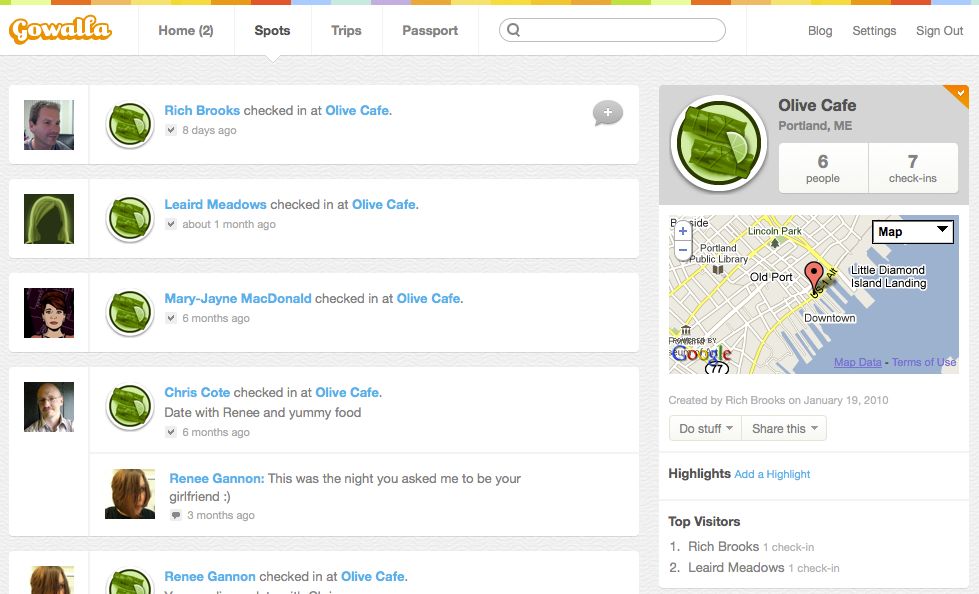
Since so many Foursquarers and Gowallites are on Twitter and Facebook, you can easily engage them once they’ve visited your place of business. You can visit your page on either of these websites to see who’s checked in recently and often find a quick link to their Facebook or Twitter account. From there you can reach out, let them know you saw their check-in, and just wanted to see if their meal, haircut, or ride on the carousel was to their liking, and if there’s anything else you can do.
Use this tactic with discretion, however. Some people may find this intrusive, even when they have opted to check in and share their location with the world.
You should also start investigating Facebook Places. At the time of this writing, there’s no ad platform on the new geo-location offering from Facebook. However, that will inevitably change, giving you the opportunity to offer discounts to shoppers who check in and share their activity with their Facebook network. Retail shops should make sure that they are listed in Facebook places so their customers can check in and share their experiences with others.
You might want to encourage the “check-in” behavior of your patrons by setting up tabletop displays with information on Foursquare, Gowalla and Facebook Places.
#5: Incentivise Your Audience to Visit
Building loyalty and connections with customers is a great long-term success strategy. However, there are plenty of ways to provide incentives for your online audience to make an in-person visit with a more immediate impact:
Create Facebook- or Twitter-only discounts or coupons that people print up and bring in. Make them good for one day only to generate more visits to your page and create a sense of urgency.
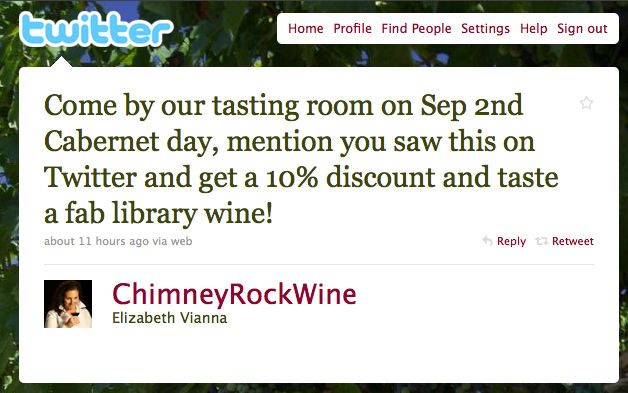
Last-minute cancellation? Blast out to your audience that you have a sudden opening that afternoon for anyone who needs a massage or mani/pedi.
Slow lunch? Announce a discount for anyone who walks in and mentions Twitter or Facebook while placing his/her order.
Announce a special event at your bar. If you roll out the mechanical bull on Wednesday night, make sure you announce it (maybe with pictures). Or if two bachelorette parties suddenly show up, a large portion of your audience may want to know. And is that Marelisa Gibson who just walked in the front door?
Now it’s your turn: what other ways have you used Twitter or Facebook to drive traffic to your own place of business? Leave your comments in the box below
